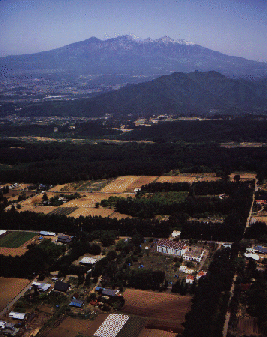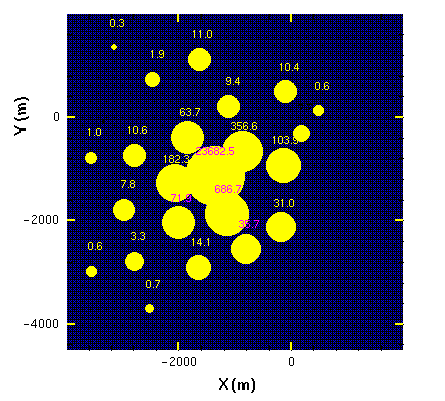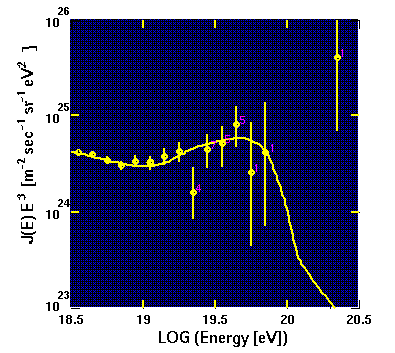
AGASA (Akeno Giant Air Shower Array)
Research Subjects
AGASA measures giant air showers initiated by the most energetic
cosmic ray particles. Why these particles are so energetic
(their energies are almost in a macro unit: more than 10J !!)
and where they traveled from has puzzled us for a long time.
Is there any energetic phenomenon in our universe powerful enough
to produce these particles? Are these extremely high energies a signature
of the Early Universe ? The AGASA is attacking these questions
and trying to get conclusive answers.
The Equipment
AGASA is the world's largest air shower array to detect cosmic rays
with energies up to 10^20 eV.
In the AGASA, 111 density detectors are arranged with an
inter-detector separation of about 1 km covering 100 km^2 area,
and they are sequentially
connected by a pair of optical fibers.
Each surface detector consists of plastic scintillators of 2.2 m^2 area,
which are viewed by a
125 mm diameter Hamamatsu R1512 photomultiplier tube (PMT).
The data acquisition system specified for this experiment
has been developed for transmitting
data to and from all the surface detectors with a flexible
response to seasonal changes of temperature, variations of gain
in the amplifiers and movement of detector positions.
The operation procedures are managed and monitored by the Sun
SPARC through an optical ethernetwork of 10Mbps.
This equipment is able to detect big air showers initiated by hadrons
and/or photons traveling through the universe, providing information
of where they come from and how they are produced.
You can see a view of the AGASA array here.
Here is a list of Collaborators
Scientific Results
- Detection of an extremely high energy particle

- We detected a very energetic cosmic ray of energy about
2x10^20eV on December 3, 1993. This is the second highest
energy particles traveling in the Universe which has ever been observed.
The above figure is a map of the particle density distribution
of this superbig event.
The radius of each circle represents the logarithm of the density
at each detector location. You can see that the associated particles
spread over a 4km x 4km area.
If this cosmic ray were a proton, its origin could be extragalactic.
However, the distance of the source cannot be
much more than a few times 10 Mpc
due to the energy loss during its travel from
interactions with universal background radiation.
There is no known active object within 50 Mpc near the
arrival direction of this shower.
Here is our paper
to report this interesting event.
- Energy Spectrum of the highest energy cosmic rays

- Measurement of the energy spectrum constrains the origin
of the energetic particles due to modifications
in the energy spectrum as a result of the interaction between
the energetic particles and the universal cosmic background radiation.
The shape of the spectrum should yield an information about the
possible distribution of sources and how long
these particles have been traveled. The above figure is
the measured energy spectrum. The solid curve shows the spectrum expected
from a model of many sources distributed homogeneously and uniformly
in the Universe. This model looks in good agreement with the measurement.
Active radio galaxies with hot spots are the best candidate
to satisfy these results, but the hypothesis that the extremely
energetic particles are produced by decay of monopoles and/or
cosmic strings predicted by GUTs may produce is also acceptable,
taking into consideration the existence of the biggest event
with an energy larger than the spectrum cutoff.
Here is our published
paper to report our spectrum measurement.
Updated energy spectrum by AGASA is also available.
- Mass composition of the highest energy cosmic rays
- We observed muon components in the detected air showers and
studied their characteristics. Generally speaking, more muons
in a shower cascade favors heavier primary hadrons and
measurement of muons is one of the methods used to infer the chemical
composition of the energetic cosmic rays. Our recent measurement
indicates no systematic change in the mass composition
from a predominantly heavy to a light composition above 0.3 EeV
claimed by the Fly's Eye group.
Here is our preprint
of the muon stuff.
Spokesperson: Motohiko Nagano mnagano@icrr.u-tokyo.ac.jp
Editor: Shigeru Yoshida
syoshida@icrr.u-tokyo.ac.jp
Go back to the AS division home page




